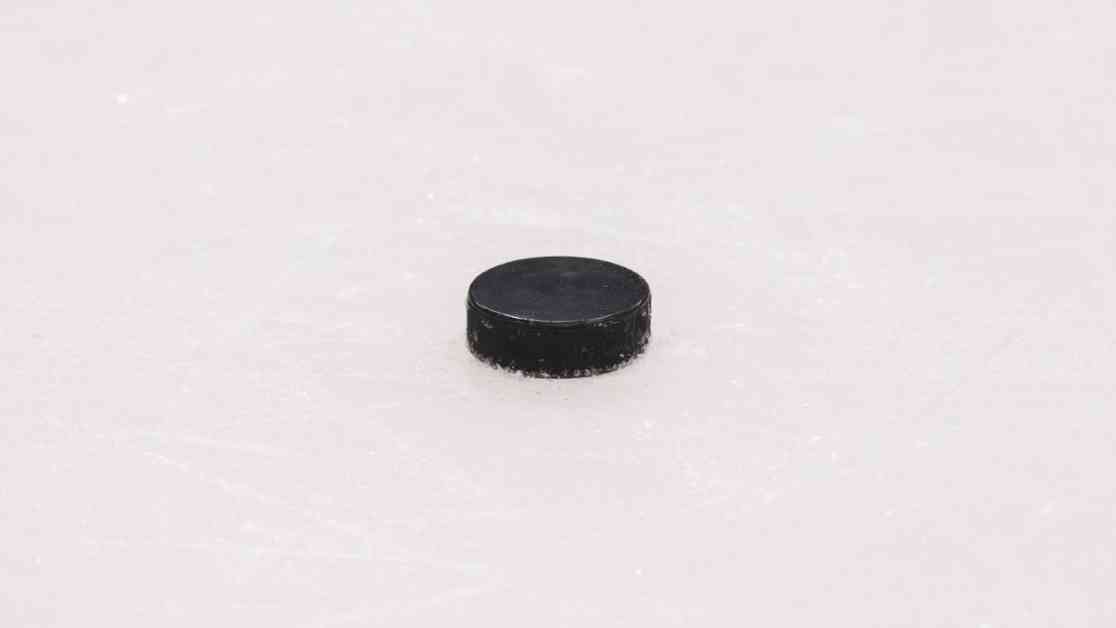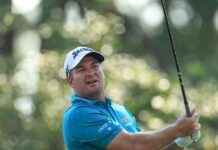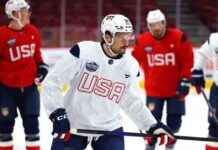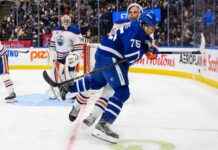The American Hockey League (AHL) has made a significant change in its safety protocols by mandating the use of cut-resistant neck protection for all players and on-ice officials starting in the 2024-25 season. This decision comes after a unanimous vote by the AHL board of governors, signaling a proactive approach to player safety in the wake of recent incidents in the hockey world.
The AHL’s move to require cut-resistant neck protection follows similar steps taken by other professional hockey leagues in response to tragic events. In October 2023, Adam Johnson, a player for the Nottingham Panthers in England’s Elite Ice Hockey League, tragically lost his life after suffering a neck laceration from an opponent’s skate blade during a game. This devastating incident served as a wake-up call for the hockey community to prioritize player safety and implement measures to prevent such accidents from happening again.
In the aftermath of Johnson’s death, the Western Hockey League and the International Ice Hockey Federation (IIHF) were among the first to mandate the use of neck protectors for their players. The decision by the AHL to follow suit demonstrates a collective effort by hockey organizations to prioritize player safety above all else. Additionally, USA Hockey and Hockey Canada have long required players under the age of 18 to wear neck guards, recognizing the importance of protecting young athletes as they develop their skills on the ice.
While the NHL currently does not mandate the use of neck guards, some players have chosen to wear them as an added layer of protection. Notable players like Erik Karlsson, Rasmus Dahlin, Nik Ehlers, and T.J. Oshie have been advocates for neck protection, setting an example for their peers and younger players. Oshie, in particular, has been instrumental in raising awareness about the importance of neck guards through his company, Warroad Hockey, which supplies protective gear to players at all levels of the sport.
NHL commissioner Gary Bettman has acknowledged the role of neck guards in enhancing player safety and has expressed his support for players who choose to wear them. While the NHL cannot unilaterally mandate the use of neck guards without the approval of the NHL Players’ Association, Bettman has encouraged players to prioritize their safety on the ice. As the hockey community continues to evolve its safety protocols, the conversation around mandatory neck protection in the NHL may gain traction in the future.
The Impact of Mandatory Neck Protection
The mandate for cut-resistant neck protection in the AHL represents a significant step forward in enhancing player safety in professional hockey. By requiring all players and on-ice officials to wear neck protectors, the AHL is setting a new standard for protective equipment in the sport. This proactive approach not only protects players from potential injuries but also sends a clear message about the league’s commitment to ensuring the well-being of its athletes.
The implementation of mandatory neck protection in the AHL is expected to have a ripple effect across the hockey community, influencing other leagues to adopt similar measures. As more players and officials prioritize their safety by wearing neck guards, the culture of player protection in hockey is likely to shift towards a more proactive and preventive approach. This change not only benefits the current generation of players but also sets a precedent for future athletes to prioritize their safety on the ice.
Challenges and Considerations
While the mandate for cut-resistant neck protection in the AHL is a positive step towards enhancing player safety, it also presents challenges and considerations for players, coaches, and officials. One of the main challenges is the adjustment period for players who may not be accustomed to wearing neck protectors during games. The fit, comfort, and mobility of neck guards may vary from player to player, requiring adjustments and adaptations to ensure optimal performance on the ice.
Coaches and team trainers will also need to educate players on the importance of wearing neck protection and provide guidance on selecting the right gear for their needs. Ensuring that players are properly equipped with approved neck guards and that they understand how to wear them correctly is essential in preventing injuries and promoting a safe playing environment. Additionally, officials and referees will need to adhere to the same standards as players when it comes to wearing mandated neck protection during games.
The Future of Player Safety in Hockey
The mandate for cut-resistant neck protection in the AHL marks a significant milestone in the ongoing conversation about player safety in hockey. As the hockey community continues to prioritize the well-being of its athletes, the adoption of new safety protocols and equipment standards will play a crucial role in preventing injuries and promoting a culture of safety on the ice. By implementing mandatory neck protection, the AHL is setting a precedent for other leagues to follow suit and prioritize player safety above all else.
Looking ahead, the conversation around player safety in hockey is likely to evolve as new technologies and innovations in protective gear become available. While neck guards are a crucial component of player safety, ongoing research and development in the field of sports medicine and equipment design will further enhance the protection offered to athletes on the ice. As the hockey community continues to adapt to changing safety standards, the future of player safety in the sport looks promising, with a focus on preventing injuries and creating a safer playing environment for all athletes.


















